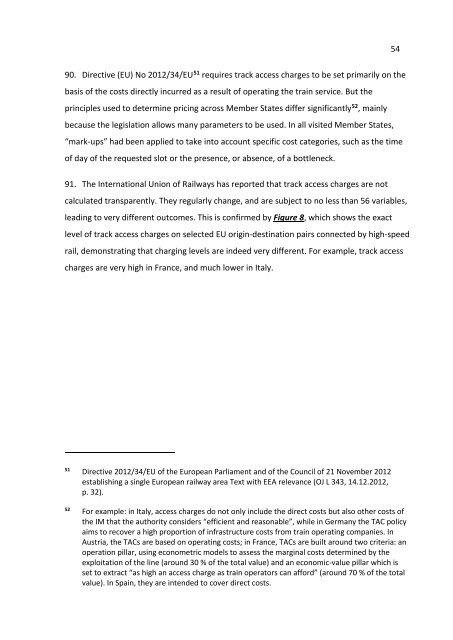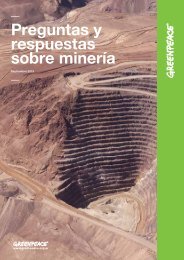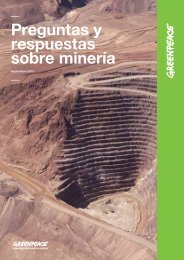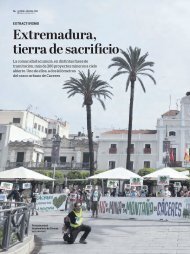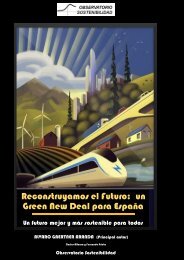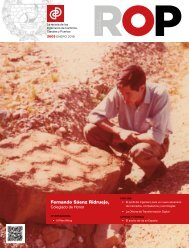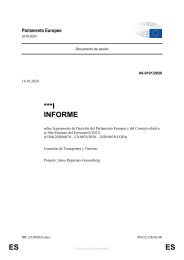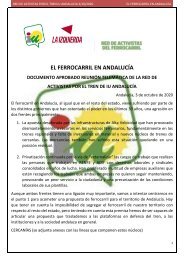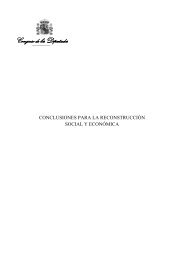La Red de Alta Velocidad Europea: Más un mosaico poco efectivo que una realidad
El presente comunicado de prensa tiene por objeto ofrecer una síntesis del contenido esencial del informe especial del Tribunal de Cuentas Europeo. El texto íntegro del informe puede consultarse en www.eca.europa.eu.
El presente comunicado de prensa tiene por objeto ofrecer una síntesis del contenido esencial del informe especial del
Tribunal de Cuentas Europeo.
El texto íntegro del informe puede consultarse en www.eca.europa.eu.
You also want an ePaper? Increase the reach of your titles
YUMPU automatically turns print PDFs into web optimized ePapers that Google loves.
54<br />
90. Directive (EU) No 2012/34/EU 51 requires track access charges to be set primarily on the<br />
basis of the costs directly incurred as a result of operating the train service. But the<br />
principles used to <strong>de</strong>termine pricing across Member States differ significantly 52 , mainly<br />
because the legislation allows many parameters to be used. In all visited Member States,<br />
“mark-ups” had been applied to take into acco<strong>un</strong>t specific cost categories, such as the time<br />
of day of the re<strong>que</strong>sted slot or the presence, or absence, of a bottleneck.<br />
91. The International Union of Railways has reported that track access charges are not<br />
calculated transparently. They regularly change, and are subject to no less than 56 variables,<br />
leading to very different outcomes. This is confirmed by Figure 8, which shows the exact<br />
level of track access charges on selected EU origin-<strong>de</strong>stination pairs connected by high-speed<br />
rail, <strong>de</strong>monstrating that charging levels are in<strong>de</strong>ed very different. For example, track access<br />
charges are very high in France, and much lower in Italy.<br />
51<br />
Directive 2012/34/EU of the <strong>Europea</strong>n Parliament and of the Co<strong>un</strong>cil of 21 November 2012<br />
establishing a single <strong>Europea</strong>n railway area Text with EEA relevance (OJ L 343, 14.12.2012,<br />
p. 32).<br />
52<br />
For example: in Italy, access charges do not only inclu<strong>de</strong> the direct costs but also other costs of<br />
the IM that the authority consi<strong>de</strong>rs “efficient and reasonable”, while in Germany the TAC policy<br />
aims to recover a high proportion of infrastructure costs from train operating companies. In<br />
Austria, the TACs are based on operating costs; in France, TACs are built aro<strong>un</strong>d two criteria: an<br />
operation pillar, using econometric mo<strong>de</strong>ls to assess the marginal costs <strong>de</strong>termined by the<br />
exploitation of the line (aro<strong>un</strong>d 30 % of the total value) and an economic-value pillar which is<br />
set to extract “as high an access charge as train operators can afford” (aro<strong>un</strong>d 70 % of the total<br />
value). In Spain, they are inten<strong>de</strong>d to cover direct costs.


